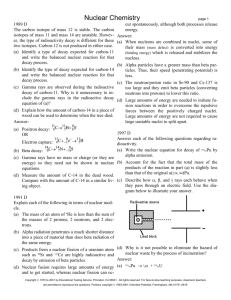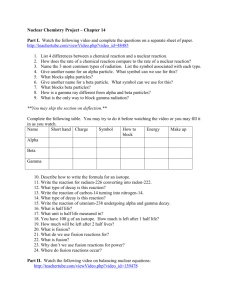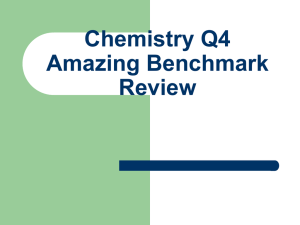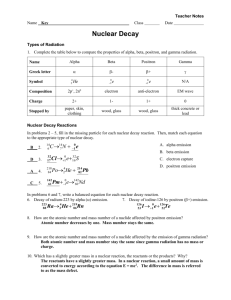Nuclear Processes project outline
advertisement
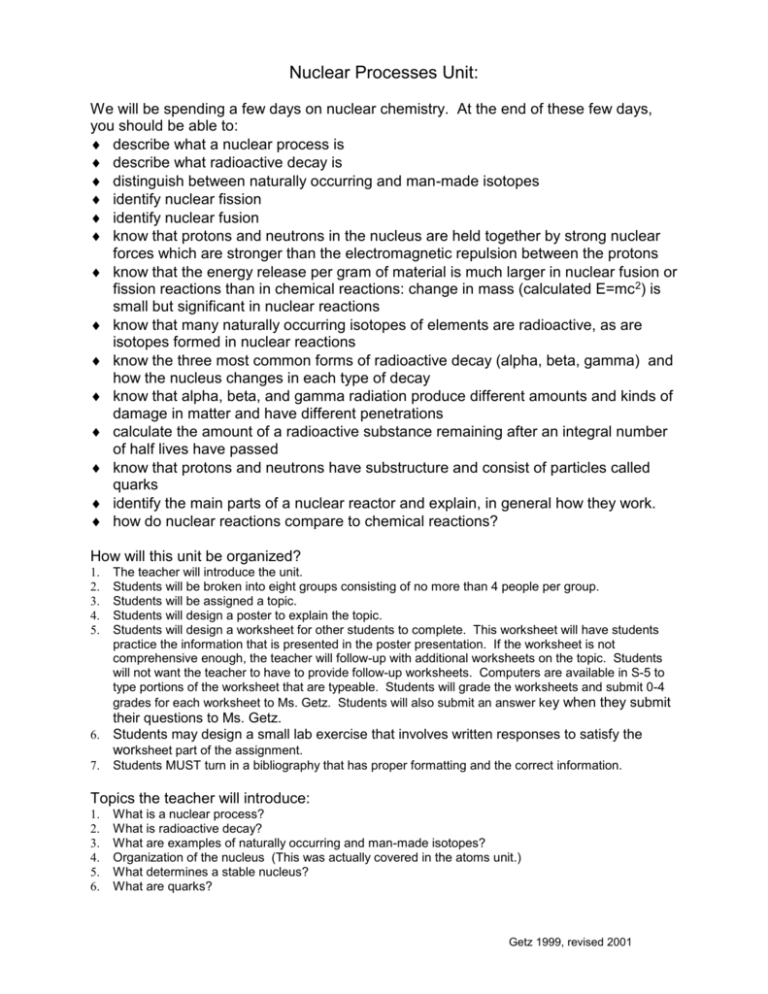
Nuclear Processes Unit: We will be spending a few days on nuclear chemistry. At the end of these few days, you should be able to: describe what a nuclear process is describe what radioactive decay is distinguish between naturally occurring and man-made isotopes identify nuclear fission identify nuclear fusion know that protons and neutrons in the nucleus are held together by strong nuclear forces which are stronger than the electromagnetic repulsion between the protons know that the energy release per gram of material is much larger in nuclear fusion or fission reactions than in chemical reactions: change in mass (calculated E=mc 2) is small but significant in nuclear reactions know that many naturally occurring isotopes of elements are radioactive, as are isotopes formed in nuclear reactions know the three most common forms of radioactive decay (alpha, beta, gamma) and how the nucleus changes in each type of decay know that alpha, beta, and gamma radiation produce different amounts and kinds of damage in matter and have different penetrations calculate the amount of a radioactive substance remaining after an integral number of half lives have passed know that protons and neutrons have substructure and consist of particles called quarks identify the main parts of a nuclear reactor and explain, in general how they work. how do nuclear reactions compare to chemical reactions? How will this unit be organized? 1. 2. 3. 4. 5. The teacher will introduce the unit. Students will be broken into eight groups consisting of no more than 4 people per group. Students will be assigned a topic. Students will design a poster to explain the topic. Students will design a worksheet for other students to complete. This worksheet will have students practice the information that is presented in the poster presentation. If the worksheet is not comprehensive enough, the teacher will follow-up with additional worksheets on the topic. Students will not want the teacher to have to provide follow-up worksheets. Computers are available in S-5 to type portions of the worksheet that are typeable. Students will grade the worksheets and submit 0-4 grades for each worksheet to Ms. Getz. Students will also submit an answer key when they submit 6. their questions to Ms. Getz. Students may design a small lab exercise that involves written responses to satisfy the worksheet part of the assignment. 7. Students MUST turn in a bibliography that has proper formatting and the correct information. Topics the teacher will introduce: 1. 2. 3. 4. 5. 6. What is a nuclear process? What is radioactive decay? What are examples of naturally occurring and man-made isotopes? Organization of the nucleus (This was actually covered in the atoms unit.) What determines a stable nucleus? What are quarks? Getz 1999, revised 2001 Topics that will be assigned to students: 1. Nuclear fission reactions. Include a discussion of the energy released per gram of material during a fission reaction. Mention how uranium undergoes fission- give an example from the uranium decay series. 2. Nuclear fusion reactions: Include a discussion of the energy released per gram of material during a fusion reaction. 3. Radioactive decay focusing on alpha decay. Give examples (and problems) that involve equations that have alpha decay. 4. Radioactive decay focusing on beta decay. Give examples (and problems) that involve equations that have beta decay. 5. Radioactive decay focusing on gamma decay. Show where gamma rays fall on the electromagnetic spectrum. 6. Half lives: What are they? What is carbon-dating? How does one calculate the amount of a radioactive substance remaining after an integral number of half lives have passed. State an equation one can use to determine the amount of half lives remaining and explain how to use the equation. 7. What is a nuclear reactor? How does a nuclear reactor work? What does a nuclear reactor look like and what do the parts of the nuclear reactor do? Mention the decay series of uranium. 8. Compare chemical reactions to nuclear reactions. Give examples of each type of reaction. Give examples of equations of each type of reaction. Standards covered: XIX: Nuclear Processes: Nuclear processes are those in which an atomic nucleus changes, including radioactive decay of naturally occurring and human-made isotopes, nuclear fission, and nuclear fusion. A. Explain that protons and neutrons in the nucleus are held together by nuclear forces that overcome the electromagnetic repulsion between the protons. B. Explain that the energy release per gram of material is much larger in nuclear fusion or fission reactions than in chemical reactions. 1. The change in mass (calculated by E = mc 2) is small but significant in nuclear reactions. C. Identify some naturally occurring isotopes of elements as being radioactive, C-1as are isotopes formed in nuclear reactions. D. identify the three most common forms of radioactive decay 1. alpha 2. beta, 3. gamma D-1 know how the nucleus changes in each type of decay 1. alpha 2. beta 3. gamma E. Explain that alpha, beta, and gamma radiation produce different amounts and kinds of damage in matter and have different penetrations. 1. damage: a. alpha b. beta c. gamma 2. different penetrations a. Alpha b. beta c. gamma F.* calculate the amount of a radioactive substance remaining after an integral number of half lives have passed. G.* explain that protons and neutrons have substructures and consist of particles called quarks. Getz 1999, revised 2001


